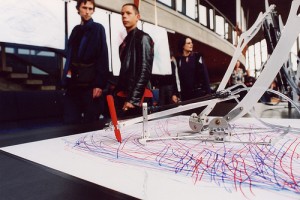Toronto’s (Canada) Art/Sci Salon (also known as, Art Science Salon) sent me an August 26, 2021 announcement (received via email) of an online show with a limited viewing period (BTW, nice play on words with the title echoing the name of the institution mentioned in the first sentence),
PROXIMAL FIELDS
The Fields Institute was closed to the public for a long time. Yet, it
has not been empty. Peculiar sounds and intriguing silences, the flows
of the few individuals and the janitors occasional visiting the building
made it surprisingly alive. Microorganisms, dust specs and other
invisible guests populated undisturbed the space while the humans were
away. The building is alive. We created site specific installations
reflecting this condition: Elaine Whittaker and her poet collaborators
take us to a journey of the microbes living in our proximal spaces. Joel
Ong and his collaborators have recorded space data in the building: the
result is an emergent digital organism. Roberta Buiani and Kavi
interpret the venue as an organism which can be taken outside on a
mobile gallery.PROXIMAL FIELDS will be visible September 8-12 2021 at
https://ars.electronica.art/newdigitaldeal/en/proximal-fields/
it [sic] is part of Ars Electronica Garden LEONARDO LASER [Anti]disciplinary Topographies
https://ars.electronica.art/newdigitaldeal/en/antidisciplinary-topographies/
see [sic] a teaser here:
With: Elaine Whittaker, Joel Ong, Nina Czegledy, Roberta Buiani, Sachin
Karghie, Ryan Martin, Racelar Ho, Kavi.
Poetry: Maureen Hynes, Sheila StewartVideo: Natalie Plociennik
This event is one of many such events being held for Ars Electronica 2021 festival.
For anyone who remembers back to my May 3, 2021 posting (scroll down to the relevant subhead; a number of events were mentioned), I featured a show from the ArtSci Salon community called ‘Proximal Spaces’, a combined poetry reading and bioart experience.
Many of the same artists and poets seem to have continued working together to develop more work based on the ‘proximal’ for a larger international audience.
International and local scene details (e.g., same show? what is Ars Electronica? etc.)
As you may have noticed from the announcement, there are a lot of different institutions involved.
Local: Fields Institute and ArtSci Salon
The Fields Institute is properly known as The Fields Institute for Research in Mathematical Sciences and is located at the University of Toronto. Here’s more from their About Us webpage,
…
Founded in 1992, the Fields Institute was initially located at the University of Waterloo. Since 1995, it has occupied a purpose-built building on the St. George Campus of the University of Toronto.
The Institute is internationally renowned for strengthening collaboration, innovation, and learning in mathematics and across a broad range of disciplines. …
…
The Fields Institute is named after the Canadian mathematician John Charles Fields (1863-1932). Fields was a pioneer and visionary who recognized the scientific, educational, and economic value of research in the mathematical sciences. Fields spent many of his early years in Berlin and, to a lesser extent, in Paris and Göttingen, the principal mathematical centres of Europe of that time. These experiences led him, after his return to Canada, to work for the public support of university research, which he did very successfully. He also organized and presided over the 1924 meeting of the International Congress of Mathematicians in Toronto. This quadrennial meeting was, and still is, the major meeting of the mathematics world.
There is no Nobel Prize in mathematics, and Fields felt strongly that there should be a comparable award to recognize the most outstanding current research in mathematics. With this in mind, he established the International Medal for Outstanding Discoveries in Mathematics, which, contrary to his personal directive, is now known as the Fields Medal. Information on Fields Medal winners can be found through the International Mathematical Union, which chooses the quadrennial recipients of the prize.
Fields’ name was given to the Institute in recognition of his seminal contributions to world mathematics and his work on behalf of high level mathematical scholarship in Canada. The Institute aims to carry on the work of Fields and to promote the wider use and understanding of mathematics in Canada.
The relationship between the Fields Institute and the ArtSci Salon is unclear to me. This can be found under Programs and Activities on the Fields Institute website,
2020-2021 ArtSci Salon
Description
ArtSci Salon consists of a series of semi-informal gatherings facilitating discussion and cross-pollination between science, technology, and the arts. ArtSci Salon started in 2010 as a spin-off of Subtle Technologies Festival to satisfy increasing demands by the audience attending the Festival to have a more frequent (monthly or bi-monthly) outlet for debate and information sharing across disciplines. In addition, it responds to the recent expansion in the GTA [Greater Toronto Area] area of a community of scientists and artists increasingly seeking collaborations across disciplines to successfully accomplish their research projects and questions.
For more details, visit our blog.
Sign up to our mailing list here.
For more information please contact:
Stephen Morris: smorris@physics.utoronto.ca
Roberta Buiani: rbuiani@gmail.com
…
We are pleased to announce our upcoming March 2021 events (more details are in the schedule below):
…
Ars Electronica
It started life as a Festival for Art, Technology and Society in 1979 in Linz, Austria. Here’s a little more from their About webpage,
…
… Since September 18, 1979, our world has changed radically, and digitization has covered almost all areas of our lives. Ars Electronica’s philosophy has remained the same over the years. Our activities are always guided by the question of what new technologies mean for our lives. Together with artists, scientists, developers, designers, entrepreneurs and activists, we shed light on current developments in our digital society and speculate about their manifestations in the future. We never ask what technology can or will be able to do, but always what it should do for us. And we don’t try to adapt to technology, but we want the development of technology to be oriented towards us. Therefore, our artistic research always focuses on ourselves, our needs, our desires, our feelings.
…
They have a number of initiatives in addition to the festival. The next festival, A New Digital Deal, runs from September 8 – 12, 2021 (Ars Electronica 2021). Here’s a little more from the festival webpage,
Ars Electronica 2021, the festival for art, technology and society, will take place from September 8 to 12. For the second time since 1979, it will be a hybrid event that includes exhibitions, concerts, talks, conferences, workshops and guided tours in Linz, Austria, and more than 80 other locations around the globe.
…
Leonardo; The International Society for Arts, Sciences and Technology
Ars Electronica and Leonardo; The International Society for Arts, Sciences and Technology (ISAST) cooperate on projects but they are two different entities. Here’s more from the About LEONARDO webpage,
Fearlessly pioneering since 1968, Leonardo serves as THE community forging a transdisciplinary network to convene, research, collaborate, and disseminate best practices at the nexus of arts, science and technology worldwide. Leonardo’ serves a network of transdisciplinary scholars, artists, scientists, technologists and thinkers, who experiment with cutting-edge, new approaches, practices, systems and solutions to tackle the most complex challenges facing humanity today.
As a not-for-profit 501(c)3 enterprising think tank, Leonardo offers a global platform for creative exploration and collaboration reaching tens of thousands of people across 135 countries. Our flagship publication, Leonardo, the world’s leading scholarly journal on transdisciplinary art, anchors a robust publishing partnership with MIT Press; our partnership with ASU [Arizona State University] infuses educational innovation with digital art and media for lifelong learning; our creative programs span thought-provoking events, exhibits, residencies and fellowships, scholarship and social enterprise ventures.
…
I have a description of Leonardo’s LASER (Leonardo Art Science Evening Rendezvous), from my March 22, 2021 posting (the Garden comes up next),
Here’s a description of the LASER talks from the Leonardo/ISAST LASER Talks event page,
“… a program of international gatherings that bring artists, scientists, humanists and technologists together for informal presentations, performances and conversations with the wider public. The mission of LASER is to encourage contribution to the cultural environment of a region by fostering interdisciplinary dialogue and opportunities for community building.”
To be specific it’s Ars Electronica Garden LEONARDO LASER and this is one of the series being held as part of the festival (A Digital New Deal). Here’s more from the [Anti]disciplinary Topographies ‘garden’ webpage,
Culturing transnational dialogue for creative hybridity
Leonardo LASER Garden gathers our global network of artists, scientists, humanists and technologists together in a series of hybrid formats addressing the world’s most pressing issues. Animated by the theme of a “new digital deal” and grounded in the UN Sustainability Goals, Leonardo LASER Garden cultivates our values of equity and inclusion by elevating underrepresented voices in a wide-ranging exploration of global challenges, digital communities and placemaking, space, networks and systems, the digital divide – and the impact of interdisciplinary art, science and technology discourse and collaboration.
Dovetailing with the launch of LASER Linz, this asynchronous multi-platform garden will highlight the best of the Leonardo Network (spanning 47 cities worldwide) and our transdisciplinary community. In “Extraordinary Times Call for Extraordinary Vision: Humanizing Digital Culture with the New Creativity Agenda & the UNSDGs [United Nations Sustainable Development Goals],” Leonardo/ISAST CEO Diana Ayton-Shenker presents our vision for shaping our global future. This will be followed by a Leonardo Community Lounge open to the general public, with the goal of encouraging contributions to the cultural environments of different regions through transnational exchange and community building.
Getting back to the beginning you can view Proximal Fields from September 8 – 12, 2021 as part of the Ars Electonica 2021 festival, specifically, the ‘garden’ series.
ETA September 8, 2021: There’s a newly posted (on the Fields Institute webspace) and undated notice/article “ArtSci Salon’s Proximal Fields debuts at the Ars Electronica Festival,” which includes an interview with members of the Proximal Fields team.

